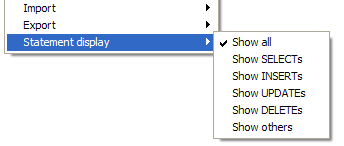As described in Opening an Existing SQL Statement, the Open SQL Statement dialog box and the Statement drop-down list each display the names of the SQL statements in the current SAM. The Statement display cascaded menu on the SQL Statement pull-down menu allows you to filter these lists by a particular statement type.
Below shows the Statement display cascaded menu.

Statement Display Cascaded Menu
The default choice on the Statement display cascaded menu is Show all. This choice shows the names of all statements in the current SAM, and is indicated as the default with a check mark.
When you select a choice on the Statement display cascaded menu, the following result occurs:
•The names of the statements of this type in the current SAM appear in the Open SQL Statement dialog box and Statement drop-down list. The statements are listed in the order in which they were created.
•The syntax of the first statement of this type appears in the SQL Editor window.
•A check appears on the Statement display cascaded menu next to the choice you selected.
The following table lists the affect of each choice on the Open SQL Statement dialog box and Statement drop-down list.
Select This Choice... |
To Display: |
Show all (default) |
The names of all statements in the current SAM |
Show SELECTs |
The names of all multi-row and single-row SELECT statements in the current SAM. |
Show INSERTs |
The names of all INSERT statements in the current SAM |
Show UPDATEs |
The names of all searched and positioned UPDATE statements in the current SAM |
Show DELETEs |
The names of all searched and positioned DELETE statements in the current SAM |
Show others |
The names of all statements other than SELECT, INSERT, UPDATE, and DELETE in the current SAM These include DDL statements such as CREATE and DROP, and DCL statements such as GRANT and REVOKE. |